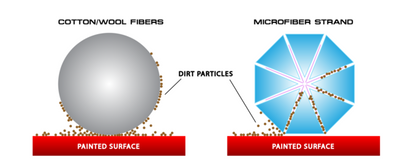Microfibre Clothes - they may all look the same but....
A retailer was recently advertising microfibre cloths for 60c each. This may sound cheap however they were not much better in quality than a cheap rag. The quality of a microfibe cloth is determined by the material reused in manufacture. With microfiber cloths, a mixture of polyamide and polyester fibres are used to produce the cloth and in general, it is said that the cheaper the product the greater the percentage of the cheaper polyester. Better quality microfibre is made using ultra microfibres that are 100 times smaller than a human hair but their star structure gives a surface area 40 times greater than a conventional cotton fibre. The star structure captures dirt particles and moisture. Microfibres are lipophilic, grease loving and hydrophilic, water-loving. This means that the fibres can attract grease and dirt as well as absorb up to 10 times their weight in water. But they can also be used effectively dry.
 |
As microfiber cloths are wiped over a surface they develop a positive charge and since the dust has a negative charge the dust is attracted and held to the cloth. A good mixture of fibres is 70% or 80% polyester and 30% or 20 % polyamide. |
The size of the cloth is also important as too small and they are awkward to use, particularly when using the 8 sided clean surface cleaning method (see touch point cleaning techniques) and the moisture holding capabilities are negated. The common commercial sized cloths are 36 x 36cm or 40 x 40cm with some now even larger and incorporating abrasive sections for deeper scrubbing. Some cloths have a raised coarser polyester surface on one side for scrubbing and the other side the flat surface for wiping.
For colour coding purposes all standard healthcare colours are available but beware that some cheaper brands can have a problem with colour running, particularly with the red cloths.
|
Good quality clothes can be laundered 600 – 750 times in a hot wash. When laundering any microfibre cleaning products fabric softener cannot be used as it clogs the pores of the fibres and will not allow the cloth to absorb moisture. For anti-bacterial purposes, silver has been infused in some microfibres. The silver is in the fibre rather than a coating so it will keep acting as an anti-bacterial agent for the life of the cloth.
|
